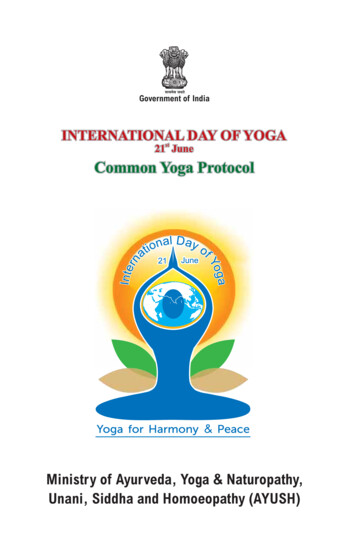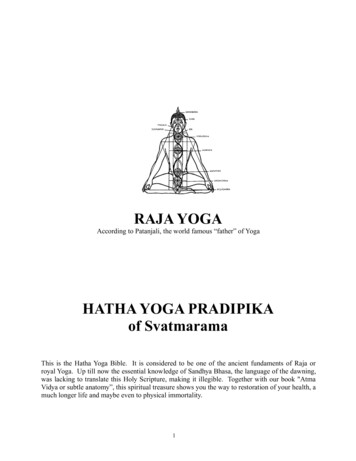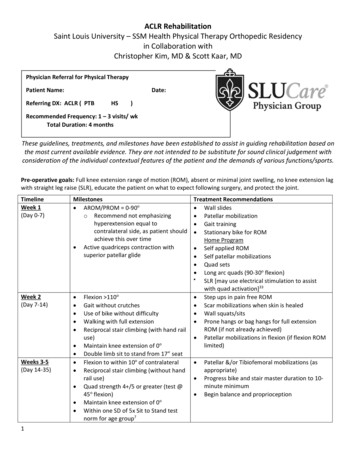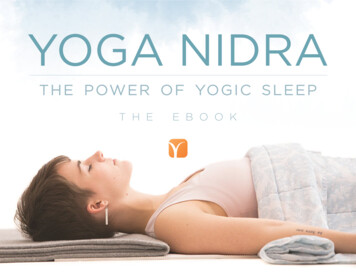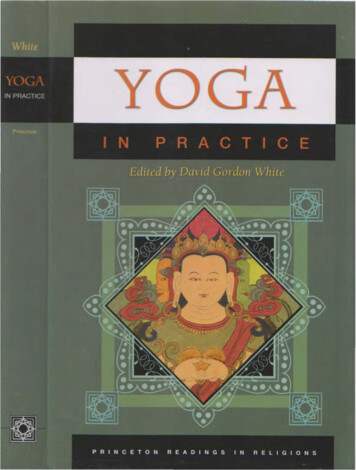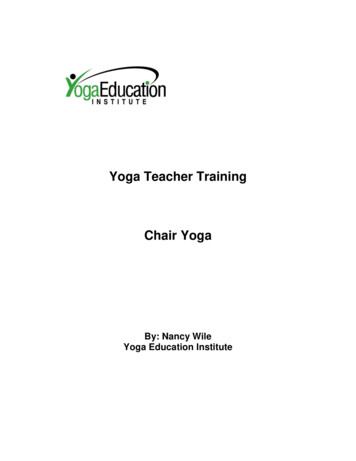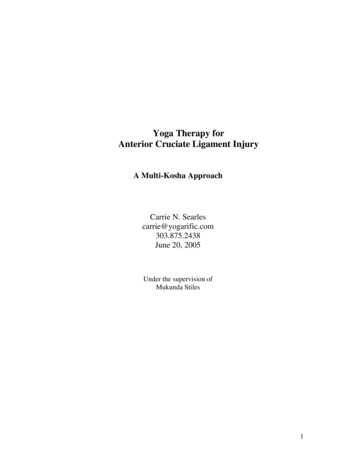
Transcription
Yoga Therapy forAnterior Cruciate Ligament InjuryA Multi-Kosha ApproachCarrie N. Searlescarrie@yogarific.com303.875.2438June 20, 2005Under the supervision ofMukunda Stiles1
1A. Case study:Alexis is a 24 year old female, 5’4” 120lbs. who has had a daily yoga practice (asana,pranayama, meditation) for 10 years. She works as a yoga instructor and a part-timesecretary for a yoga therapist. Although she has taught and practiced yoga for a long timeshe is still insecure in her profession.Tuesday morning, May 11 2004, Alexis received an insight while meditating: “while Ienjoy playing recreational soccer, it does not support my dharma, or my purpose, I shouldquit.” As a result Alexis decided to stop playing soccer at the end of the season. Aftermeditation, she picked up her voice mail. One of the messages was from her indoorsoccer league, “the team was dissolved, no soccer game tonight, or for the rest of theseason.” This left Alexis with just an outdoor soccer league team, one game a week forthe next six weeks.Saturday May 15 was a bright sunny day. Alexis was a little tired, she did not warm upbefore the game and was near the end of her menstrual flow. While running a straightline, no one around her, she started to stop, initiating a weight-bearing movement) and inthe process she felt her knee joint move medially and then back into place, while makinga distinct popping/shifting sound. This left Alexis on her knees. She knew she was hurt,and she should not walk on the injured limb, so she asked for help off the field. Aftersome confusion her teammates understood there was something wrong. They carried heronto the sidelines.Once on the sidelines Alexis applied the yoga technique of breath awareness,visualization and pranayama. She held her hands around her knee and imagined love andlight around the area of pain. She wrapped the knee in an ace bandage (a way to applycompression to the joint to reduce swelling) and kept ice over it. After 30 minutes thepain subsided. She then slowly walked/limped back to her car and drove home.Alexis did not walk for several hours, her knee began to swell and the joint became stiff.This is very common in an ACL injury, partial tear or rupture of the ligament. In Sportsmedicine they have the acronym R.I.C.E. in regards to the first steps in handling a sports(or any other traumatic) injury. Rest, Ice, Compression, and Elevation.Rest: to calm vata, allow the joint to healIce: to reduce pitta, inflammationCompression (tightly wrapping the joint with an ace bandage): to reduce kapha,swelling and immobility.Elevation: to improve circulation (V-P-K)The RICE method works on calming all the doshas at the first kosha.1B. Physical Assessment and Findings:June 6th, 2004.2
Alexis tracks well when walking a straight line. When walking up stairs her right kneemoves medially, probably to avoid pressure on the medial meniscus of the knee due to apossible tear in the cartilage.Client says that there is brief pain when she takes her right leg through full range ofmotion, mostly noticeable when carrying heavy objects. She has found that the regularuse of BFS crème1 takes the pain away. If she skips a day in applying the ointment shefeels discomfort.By December of 2004 (seven months post injury) Alexis started applying the BFS crèmewith less frequency and still felt comfortable.Twelve months after the injury Alexis would apply the crème maybe once a week. Sheconsidered this treatment as a maintenance and precautionary measure rather then anecessity to abate pain.C. Summary of Findings:Right kneeROMMay 16R: 5 Left KneeL: 155 May 22R: 135 155 May 29148 155 At the end of the second week after injury, Alexis was back to her normal yoga routine,except for positions that required full knee flexion such as kneeling, or complete fullsquats.After five months, Alexis was at full flexion 155 on both knees.After six months Alexis was comfortable doing full squats, bearing full weight on right(previously injured knee) for 30 seconds with sustained comfort.D. Recommendations:The first step, as in any traumatic injury, was to reduce the trauma of the joint andsurrounding muscles. Trauma is a vata imbalance. This can appear as extreme tension orrigidity of the muscles, guarding of the injured area, mental fear of using the joint oraffected area, and pain. The body cannot move on and heal if it is still in a traumaticstate.The quality of vata is balanced by warmth, gentleness, oiliness, massage, breathwork,pranayama, love, tenderness, etc.1For more information on BFS crème see page 17.3
Alexis applied these techniques by practicing the Joint Freeing Series twice a day,eliminating the other asanas she was practicing previous to the injury. When goingthrough the Joint Freeing Series she went slowly, with awareness, breathing into eachjoint as it was moving. Alexis did not bend or flex her right knee, as it was still in atraumatic phase of the injury, but left it straight and visualized doing the movement.Hence she was able to work with the knee therapeutically from the Prana Maya (breath)and Mano Maya (mental) kosha. She then continued to do the rest of the Joint FreeingSeries, adapting so as to not hurt, or move her right knee.She oiled her knee with a therapeutic salve, called BFS, or BFC, which stands forBone, Flesh, and Sinew, or Bone Flesh and Cartilage respectively. When applying thesalve she would rub the ointment onto the skin with the intention of rubbing the oil firstinto the muscles around the knee, then the ligaments, tendons and finally around the joint.She took arnica2 internally for a week to help with damaged tissue.Another technique Alexis used was therapeutic walking. While walking on herstiff and rigid leg she would go slowly and gently, so as not to feel any pain whilemoving. She directed prana and breath into the areas of the muscle that were still intrauma. She would talk to the muscles, recognizing that yes, they did indeed go througha traumatic event, and yes, it is okay and safe to start moving again. She promised themuscles that she would do her best to rehabilitate her knee and do whatever she could toprevent this event from happening again.Alexis also received a massage around the area of the affected knee to helpmanually relax the muscles, her Tensor Fascia Latae and Rectus Femoris were especiallytight.Medical Treatment and AssessmentWednesday May 19, 2004.Doctor #1:After examining Alexis’s knee the doctor explained that the ACL was ruptured without adoubt. He is “95% sure,” and as a result won’t authorize an MRI. Alexis asked severalquestions about her options, including doing surgery, not doing surgery, possibility ofliving without an ACL, and the possibility that the ACL could heal on its own. Thedoctor recommended having surgery especially since she was very young and active. Heexplained that the procedure is very common with a high success rate. He said thatwithout surgery Alexis would have to limit the movement of her knee, no planting orpivoting, no deep squats. To the possibility of the ACL healing on its own, the Doctorsaid yes, it is possible for the ACL to heal, but it would create so much scar tissue that itis not functional and gets in the way of the posterior ligament.Upon leaving Alexis had a prescription to go to pre-surgery physical therapy. Theprescription stated “Increase range of motion, reduce swelling, prepare for ACL surgery,counseling.”Thursday May 27, 2004.Doctor #2.2For more information on Arnica Montana see page 16.4
At this point Alexis has normal range of motion in her injured knee, and it had notsubflexed (moved out of position) or shown any other sign of being unstable.Alexis was first examined by a nurse where she stated her concerns and curiousityof the initial Doctor’s findings. She was doubtful of his diagnosis considering she wasfeeling well and was functional in her knee—ten days post injury. With this informationthe doctor came and examined her knee, and came to the same diagnosis as the firstdoctor—the ACL was ruptured, the ligament was severed completely. In the drawer andLachman’s test3 there is no catching whatsoever. He would not order an MRI, saying itwas very obvious the ACL was ruptured and he did not want to spend the money onsomething that was already so certain. The doctor did admit that Alexis was walkingnormally and that this was abnormal for a person who had suffered from a ruptured ACL,especially ten days after the injury. The recommendation was still the same however:surgery. The reasons were the same also, youth and active lifestyle.Physical Therapy:Monday May 24, 2004.Alexis came into physical therapy more out of curiosity then for the need to increaseROM and reduce swelling in her injured knee. She was still undecided on whether tohave surgery and was interested to see what physical therapy would be like. During theinitial evaluation the physical therapist was surprised that Alexis only experienced painfor the first 30 minutes after the injury. She was also surprised that she was basicallyback to practicing her normal yoga routine which included poses such as VirabhadrasanaVariation II (Warrior II) which put the knee at an angle. After assessing ROM thefindings showed that the right knee had 135º mobility, normal, but less then the left kneewhich was at 155º mobility. During this session Alexis received exercises to helpincrease strength of her hamstrings and the quadriceps Vastus Medialis, which are themuscles that help support the knee. The therapist examined Alexis’s proprioceptionskills and ability to jump, pivot, stand on the injured leg and bend and straighten the kneeon the floor and then with the foot on the edge of a step.4 After all these examinations inwhich Alexis excelled in doing without any pain or sign of instability the physicaltherapist was perplexed. She confided that there really was no need for more physicaltherapy but to go ahead and schedule two more sessions.Wednesday May 26, 2004.Alexis came in for a second physical therapy appointment where she went through moreof the same strengthening and endurance tests as she did the visit prior. She observedother patients in the clinic who were going through different stages of ACL replacementrehabilitation and decided it did not look pleasant, and often times painful in the34For more information on the Drawer and Lachman’s test see page 30.See page 31 for specific physical therapy exercises.5
beginning phases. Upon leaving the therapist said she was interested to hear the secondopinion from the other orthopedic surgeon Alexis was scheduled to see the following day.Friday May 28, 2004.Alexis reported to her physical therapist that the second doctor gave the samerecommendation as the first. By the end of the session the therapist confided in Alexisthat if she was in her position, with her knee, she would not get surgery—rehabilitation islong and painful, and if the knee is already fully functional why go through something solong and arduous when it is not necessary. The only way to know for sure if a ligament isruptured is through an MRI.One year later:Tuesday May 10, 2005.It had been almost a year since Alexis injured her knee and she wanted to have her kneere-examined as a precautionary and maintenance measure. She saw a physician’sassistant who specialized in orthopedics. After talking with Alexis and getting herhistory, the P.A. examined her knee. He said yes the right knee has more flex then theleft, however it does catch. He could not say if it was just a partial tear or a rupture fromthe movement of the knee. He then did other knee evaluation tests. The P.A. stated thatthe knee tested very healthy, the joint was solid and stable. He continued saying that hewould not see why any doctor would want to do surgery on her knee, with it being sostrong stable and considering that she has had no problems with her knee since the injuryone year ago.6
“In order to heal, you must heal on all the koshas.”Nischala Joy Devi5KoshasAfter sustaining this injury Alexis delved into a whirl wind of thoughts,confusion, and self-inquiry. Why did this happen? And what are all these new emotionsthat are being experienced? When Alexis fell to her knees and had to ask to be carried offthe field, she was very humbled. It had been a long time since she had felt this way, andnow she had a tangible experience to associate with this word.A ligament carries the qualities of kapha: strong, stable, protective, static. Thisligament was ruptured in Alexis’s body, and all the emotions that were stored in thereinwere now circulating throughout her system, at the surface of her consciousness too feeland experience once again. Kapha is the store house of deep seated emotions, and deepseated emotions that Alexis had tucked away were now being felt again. The qualities ofdevotion, surrender and feelings associated with religious practices and rituals—that shehad forgotten and stored due to deep emotional scars—were now being remembered.Through contemplation and discussions with her yoga instructor, Alexis gained aninsight (fourth kosha, vignana maya kosha). She was not precisely sure what her dharmawas, but was very much afraid of the power that she may channel when living out herdharma. As a result of this fear she was running away, and in her pride she was doingwhat she wanted to do her way. Alexis was afraid that this power may lead to nonvirtuous behavior.Her instructor suggested that she approach her power from a kapha perspective,with devotion. One could do this through surrendering one’s own power to a higherpower, such as a religious figure, saint, or simply all of humanity. This suggestion onceagain brought back memories of a time when Alexis did do this, and was emotionallyscarred by the people she was around concerning her devotion.As a result this completed the circle. Alexis realized that she needed to cultivatesurrender and devotion in her life again, and in order to do that she needed to heal theemotional wounds that caused her to lose her devotion nine years ago.Alexis set up an appointment with a behavior kinesiologist. Behavioralkinesiology is where one accesses the subconscious thoughts through putting pressureagainst a muscle and observing its energy change, strength versus weakness. With thisinformation one can make changes at the cellular level. Sue Meyer, a prominentBehavioral Kinesiologist explains that “with resolution integration we can access yourpersonal computer, and discover what fears, attitudes or beliefs are holding back yourprogress or healing.” Alexis’s intentions in the session where twofold: to eliminate theobstacles and thought habits that blocked her from practicing devotion and movingtowards her dharma; and to change the thought habit of functioning out of pride and ego.The following week Alexis set time aside to spend a week isolated in themountains to focus on healing on all koshas. She had discovered that the body canfunction on two different levels. The level of activity is where the body functionsnormally, doing daily activities. The level of rest/heal/rejuvenation happens when the5Email correspondence date May 30th, 2004.7
body is stationary and very little energy is expended. When the body is still for anextended period of time it is given the opportunity to move into the rest and heal mode.Personal RetreatActivities applied to heal on the Anno Maya Kosha (physical level): Eating foods that were sattvic and filled with ojas, giving the body fuel to healand build. These foods were: basmati rice, dates, almonds, squash, sesame seedchews, rooibos, and chamomile tea. Immobilized the injured knee by wrapping it with ace bandages. She also walkedwith a cane to prevent any weight bearing activities on the injured knee. Alexispracticed immobilizing the knee two weeks prior to the retreat, when she camehome from work, and while sleeping.Activities applied to heal on the Prana Maya Kosha (energetic level): Pranayama; both physical breathing practices and mentally directing subtleenergy to knee joint. Visualization ReikiActivities applied to heal on the Mano Maya Kosha (mental level): Read devotional books, yogic texts. Watched movie (4 times) on Mother Theresa, a woman who lived a lifecompletely out of devotion and surrender. Journaling.During the night and (later also in the day) Alexis would jolt out of sleep feeling intenseconcentration of heat running along the path of where the ACL is located in her rightknee. Sometimes she would encourage this feeling and Reiki her knee, and incorporatevisualizations. Sometimes this feeling was so intense she would remove her brace andflex her knee to dissipate the heat.Alexis noticed that after the behavior kinesiology session and personal retreat that heroutlook on life was very different. It included aspects of devotion and surrender. Sherealized that in order to maintain a healthy body she would need to adapt these outlooksfor the rest of her life.8
E. Summary of Results:Alexis applied practices to reduce swelling and eliminate the trauma within the joint.She then strengthened the hamstrings and quadriceps to support the knee. Third, shecompletely rested her knee joint for over three days to allow the knee to heal. Whileresting the knee she made strives to incorporate a lifestyle that is more flowing, withhumility and devotion. After one year Alexis has not experienced any knee problemsand is able to accomplish her activities of daily living with ease. At a medicalevaluation one year post injury the P.A. did not recommend surgery.9
2A. Name and description:Physical anatomy of the kneeFocus: Anterior Cruciate LigamentLeft kneeThe ligaments that support the knee are: pataller ligament, anterior cruciate ligament,posterior cruciate ligament, tibial collateral ligament, and fibular collateral ligament.The patellar ligament contains the patella. This ligament can be viewed as acontinuation of the tendon of the quadriceps muscles, whose fibers cross over each otherat the knee joint.The anterior cruciate ligament resists anterior displacement of the tibia on the femur,while the posterior cruciate ligament resists posterior displacement.The joint capsule is reinforced by two collateral ligaments on either side. The medial(tibial) collateral ligament functions to stabilize the joint and prevent it from opening onthe medial side. The lateral (fibular) collateral ligament prevents the joint fromopening on the lateral side (Calais-Germain, pg. 197-199).10
The muscles that extend the knee: Quadriceps: rectus femoris, vastus medialis, vastuslateralis, vastus intermedius; gracilis, and tensor fasciae latae.The muscles that cause the knee to flex: Hamstrings: biceps femoris, semitendinosus,semimembranosus. Gastrocnemius assists. Popliteus assists by initiating the rotation ofthe tibia to “unlock” the extended knee.Energetic anatomy of kneeVayu: Apana prana vayuMental anatomy of kneefrom Heal Your Body by Louise Hay:ProblemProbable CauseKneeRepresents Pride and EgoKnee ProblemsStubborn ego and pride.Inability to bend. Fear.Inflexibility. Won’t give in.New Thought PatternI am flexible and flowing.Forgiveness. Understanding.Compassion. I bend and flow withease, and all is well.11
Function of the ACLThe anterior cruciate ligament prevents hyperextension (overstraightening) of the kneeand is the primary restraint to anterior displacement of the tibia. The intact anteriorcruciate ligament is a secondary stabiliser to varus and valgus (side to side) stress at theknee, and also plays a role in limiting internal rotation of the cl.htmlACL ImageThis photo shows a rugby player with a combination of weightbearing and twisting stress, plus quadriceps (frontal thigh) musclecontraction stress, being placed on his left knee (see arrow).While such forces can easily cause a knee with a loose or tornACL to "go out" or sublux (shift out of place), they can alsooccasionally cause a healthy ACL to tear suddenly. That is exactlywhat happened to this athlete at the very instant this photo wastaken! He went on to have his ACL reconstructed with a hamstringtendon graft and had an excellent result.http://www.kneeandshoulder.md/print/print acl.html12
2B. Gross and Subtle Body common Symptoms: Pain at the time of impact which dies away afterwards.A distinct popping sound at the time of injury.Swelling—possibly due to bleeding inside the joint.Possible instability in the joint once the swelling has subsided.Pain when you bend the leg and have the tibia (lower leg bone) pulled forwards.Later symptoms: arthritis2C. Related Challenges:A person with an injured ACL will need to discontinue playing sports or any otheractivities requiring planting, pivoting, and other sudden movements of the knee. Theymay be able to play again once the knee has healed through surgery or other means, orsimply wear a brace when participating in any activities that put stress on the knee.Subconsious movements, where the knee is just slightly flexed, yet the hamstrings are notengaged are often the instances where the knee will go out, and this can eventually causearthritis.13
3. Ayurvedic AssessmentAyurvedic understanding of a ruptured ACLWhen there is a tear or rupture of a ligament, pitta is going into kahpa.The kapha qualities of a ligament are firm and stable. They hold things together withincertain boundaries, it is contained and strong. The ligament physically is dense, thick andinflexible.The qualities of pitta create stretch and heat. When a ligament is over stretched there isan excess of pitta. When a ligament is torn, there is a moderate excess of pitta. When aligament is ruptured there is an extreme excess of pitta.Ayurvedic treatments applied:Bath soak with Baking Soda and Ginger.Æ Ginger to: extract amaÆ Baking soda to: relax musclesAbhyanga: Oiling with massage.Pancha Karma:Specifically virechana, in yoga it is called varisara dhouti, or shankhaprakshalana.Virechana is an excellent way to eliminate excessive pitta ama (toxins) in the body. Witha ruptured ligament, pitta toxins from the injury circulate throughout the body and thensettle in the joints of the body. Virechana when practiced with the proper preliminaryprocedures of internal and external oiling of the body brings the ama out of the joints, andout of the system. This gives a sense of lightness and comfort and mobility in the joints.Once the joint is cleansed it is then able to repair and heal itself with more efficiency.One must have knee stability before performing full virechana.A mild virechana may be performed by drinking 2 cups of salt water with 1 ½ teaspoonsof rock salt.Dr. Lad also recommends drinking 1 cup of ginger tea with 2 teaspoons of castor oilbefore bed. Castor oil contains natural precursors of steroids, which help healinflammatory conditions (Lad, The Complete Book of Ayurvedic Home Remedies, p.130).14
Supplements used:Arnica Montana is an anti-inflammatory homeopathic supplement. It encourages whiteblood cell activity therefore hastening the removal of the blood and fluids which causebruising and swelling. It is best taken for acute or traumatic injuries.Glucosamine Chondroitin: Glucosamine and chondroitin sulfate are substances foundnaturally in the body. Glucosamine is a form of amino sugar that is believed to play a rolein cartilage formation and repair. Chondroitin sulfate is part of a large protein molecule(proteoglycan) that gives cartilage elasticity.Both glucosamine and chondroitin sulfate are sold as dietary or nutritional supplements.They are extracted from animal tissue: glucosamine from crab, lobster or shrimp shells;and chondroitin sulfate from animal cartilage, such as tracheas or shark herapies/Glucosamine.aspBone, Flesh & Cartilage (BFS) also known as Bone, Flesh, and Sinew is an herbalointment made by Nature’s Way. It is excellent in working with conditions listed in theproduct name. When applying it is best to hold the intention of first rubbing the ointmenttopically onto the skin, then deeper into the tissues, the bones, ligaments, and finally thejoint.It is made of Olive oil, Wheat Germ oil, Beeswax, Honey, Comfrey root, White Oakbark, Mullein leaf, Black Walnut leaf, Marshmallow root, Wormwood leaf, Gravel root,Scullcap leaf, Lobelia leaf.15
The DoshasCharaka, the great Ayurvedic physician of ancient times, found that all organicand inorganic substances, as well as all thoughts and actions, have definite attributes.According to Ayurveda, there are twenty basic attributes Charaka categorized theseattributes into 10 opposites pairs. Basically, the universe is the manifestation of thetwo opposites, male and female energy. (Lad, Textbook of Ayurveda FundamentalPrinciples, p. 30-31).The 20 attributes (in their pairs) are:1. Cold/Hot2. Wet/Dry3. Heavy/Light4. Gross/Subtle5. Dense/Flowing6. Static/Mobile7. Dull/Sharp8. Soft/Hard9. Smooth/Rough10. Cloudy/ClearThe twenty attributes in relationship to the doshas:Vata:Dry, light, cold, rough, subtle, mobile, clear.Qualities to balance vata post traumatic injury: warmth, nurturing, warm oil, gentlemassage, loving kindness, rest, use of breath, and other subtle practices.PittaHot, sharp, light, liquid, mobile, oily.Qualities to balance pitta post traumatic injury: cool, calm, eliminate intensity,increase range of motion with gentle movement and exercises, eliminate excess bile andacidity in the body.KaphaHeavy, slow/dull, cold, oily, liquid, slimy/smooth, dense, soft, static, sticky/cloudy, hard,gross.Qualities to balance kapha post traumatic injury: reduce swelling, increase strength,endurance, and mobility.16
Five KoshasAnna Maya Kosha:Anna means food. This is the physical aspect of the body. This kosha isstrengthened and purified through shat karmas (cleansing practices), exercise ingeneral, asanas, and a nutritious organic diet.Prana Maya Kosha:Prana means energy. This is the energetic aspect of the body. Pranayama andpratyahara strengthen and purify this kosha. This prana feeds the physical bodyand the mind.Mano Maya Kosha:This is the mental (mind) aspect of the body. Dharana, dhyana, and samadhistrengthen and purify this kosha.Vijnana Maya Kosha:This is the body of higher wisdom, or intuition. When the body is happy, and themind is happy, prana can stay home, at the Prana Maya Kosha and increase.When the pranic bank is full, one can access the Vijnana Maya Kosha.Ananda Maya Kosha:This is the body of bliss, joy and peace.Curing vs. HealingHealing to unify, to yoga—creating a healing shift at all koshas so that one will have adifferent, better perspective in life.Curing to fix the physical body.66From Nischala Joy Devi’s Cardiac Teacher Training course.17
4. Common Body Reading:A person with a torn, or ruptured ACL will have excessive anterior movement ofthe tibia when being pulled away from the femur. Activities such as going down stairsmay cause the tibia to move forward excessively. The person may not track straight,their knee may move slightly medially or laterally when walking to avoid pain in thejoint. They may also avoid activities that require planting and pivoting of the foot.5. Contraindicated Yoga Practices:Avoid positions that flex the knee more the 135 such as full knee squats orkneeling.6. General recommendations:a. Therapeutic/Free of Pain:1. R.I.C.E.; rest, ice, compression and elevation of the joint.2. Eliminate trauma in joint with vata pacifying techniques: gentle joint freeingseries, oiling and massage, rest, yoga relaxation.3. Reduce swelling and establish normal range of motion.b. Stabilizing the Situation:4. Discontinue any rigorous activity or sport until knee is stronger, use protectiveknee brace afterwards if necessary.5. Strengthen muscles of knee joint, the hamstrings and quadriceps, so that the kneewill be support and not ‘subflux,’ or shift out of place. The hamstring wraparound from the back of the knee and insert on the tibia and fibula, thus acting asknee stabilizers.6. Shift into rest and rejuvenation mode. Evaluate on all koshas, what shift needs totake place, then rest the knee joint for 3-7 consecutive days—apply these lifeshifts.7. Have a conscious awareness of movement from a closed hip position to an openhip position, also in weight bearing movements of the foot. These movementscan cause the knee to shift.c. -Maintenance:8. Maintain muscle strength.9. Sustain a daily practice to cultivate devotion and surrender.18
7. Yoga Forums:Subject: Alternative ligament building therapy?Date: Thu Dec 23, 2004Q—Hi Mukunda,I have found out about this forum through a friend who practices structural yoga therapy.My question might be a little off topic here, but I hope you may have some advice.I have a friend who has been practicing ashtanga yoga for about 15 years, and has beenrecently diagnosed with a mild version of a connective tissue disorder called ehler'sdanlos syndrome. It seems that the root of the problem is a missing protein in collagenformation which leads to extremely elastic ligaments & cartilage tissue. Onemanifestation is extreme flexibility, even double jointedness, which has made the practiceof advanced asana fairly easy. It has also led to multiple small horizontal tears in the kneeand shoulder ligaments. At this point, arthroscopic surgery, to knit together the ligamenttears has been suggested as an option which would lead to recovery & full mobility.However, sometimes the results of such surgery may lead to other complications, and it isan invasive procedure, so I am trying to do research on any dietary, herbal & physicaltherapy & lifestyle changes that might be effective to slow down, stop, or even reversesome of the damage.A vegetarian version of glucosamine has now become available, and we will try that, butany additional suggestions or references would be greatly appreciated.Namaste.A— In the past few days
Alexis is a 24 year old female, 5'4" 120lbs. who has had a daily yoga practice (asana, pranayama, meditation) for 10 years. She works as a yoga instructor and a part-time secretary for a yoga therapist. Although she has taught and practiced yoga for a long time she is still insecure in her profession.
